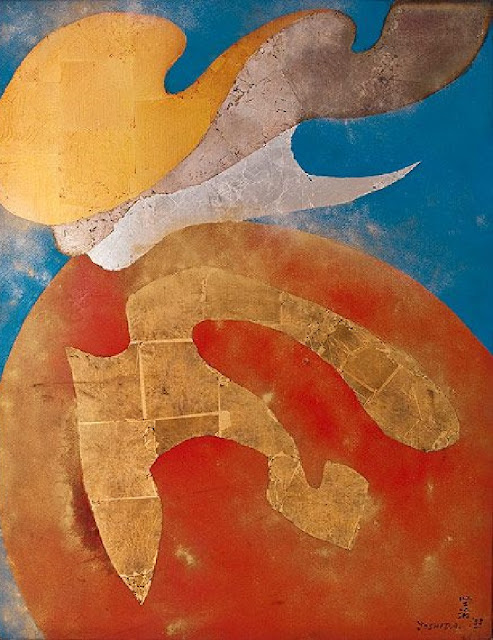Kenji Yoshida, artist, born 24 May 1924, died 24 February 2009
"Yoshida was born in 1924 in Ikeda City (part of present day Osaka). He studied art under the great Hayashi Kiyoshi and also Furukido Masaru, before those studies were interrupted by the war. Selected for training as a kami-kaze pilot, as part of the Special Attack Squadrons of the Japanese Naval Air Force, Yoshida was extremely lucky to survive his teens – though the majority of his close friends were not so fortunate. After the close of hostilities, the memory of the traumatic experience of having walked so near to death spurred Yoshida to throw himself single-mindedly into his art again and devote himself to a sustained exploration of the life-affirming forces that he had seen so nearly extinguished. From that point onwards the majority of his work has carried the single, haunting and most telling of all titles: Life.In 1964, Yoshida moved to Paris where he lived until 2009. He trained with the renowned English artist Stanley Hayter, and worked for many years at Hayter’s well-known studio Atelier 17. In 1993 the quality of Yoshida’s work was recognised when he was honoured to be the first living artist ever to be given a solo exhibition at the Japanese Galleries of the British Museum. During the Festival of Canterbury 2004, his magnificent octagonal installation, Sei-Mei, (Life-Force)could be seen in Canterbury Cathedral. In 2006 the Chateau de Blois, in the Loire Valley held a major solo exhibition of his work. The October Gallery has shown regular exhibitions of Yoshida’s work since the early 90s, the most recent one being in 2007. Sadly, this wonderful artist passed away in Japan in 2009. His contribution to the exchange of culture between Japan and the West was acknowledged in a special programme broadcast by NHK (the Japanese National Broadcasting Service) in August 2010 timed to coincide with the commerative services for the cessation of the Pacific War.Yoshida's marvelous canvases owe much to the traditional screens of his native Japan in their use of precious metals, gold, silver, copper and platinum, applied in thin sheets over a binding layer of Japanese lacquer. They can be construed as momentary apperceptions of the transcendent power of the life force stirring both within us and around us, allowing his audience privileged access to the serene beauty of an otherwise intangible series of linked progressions that describe the very processes of Life itself. "(octobergallery.co.uk)
"Yoshida was born in 1924 in Ikeda City (part of present day Osaka). He studied art under the great Hayashi Kiyoshi and also Furukido Masaru, before those studies were interrupted by the war. Selected for training as a kami-kaze pilot, as part of the Special Attack Squadrons of the Japanese Naval Air Force, Yoshida was extremely lucky to survive his teens – though the majority of his close friends were not so fortunate. After the close of hostilities, the memory of the traumatic experience of having walked so near to death spurred Yoshida to throw himself single-mindedly into his art again and devote himself to a sustained exploration of the life-affirming forces that he had seen so nearly extinguished. From that point onwards the majority of his work has carried the single, haunting and most telling of all titles: Life.In 1964, Yoshida moved to Paris where he lived until 2009. He trained with the renowned English artist Stanley Hayter, and worked for many years at Hayter’s well-known studio Atelier 17. In 1993 the quality of Yoshida’s work was recognised when he was honoured to be the first living artist ever to be given a solo exhibition at the Japanese Galleries of the British Museum. During the Festival of Canterbury 2004, his magnificent octagonal installation, Sei-Mei, (Life-Force)could be seen in Canterbury Cathedral. In 2006 the Chateau de Blois, in the Loire Valley held a major solo exhibition of his work. The October Gallery has shown regular exhibitions of Yoshida’s work since the early 90s, the most recent one being in 2007. Sadly, this wonderful artist passed away in Japan in 2009. His contribution to the exchange of culture between Japan and the West was acknowledged in a special programme broadcast by NHK (the Japanese National Broadcasting Service) in August 2010 timed to coincide with the commerative services for the cessation of the Pacific War.Yoshida's marvelous canvases owe much to the traditional screens of his native Japan in their use of precious metals, gold, silver, copper and platinum, applied in thin sheets over a binding layer of Japanese lacquer. They can be construed as momentary apperceptions of the transcendent power of the life force stirring both within us and around us, allowing his audience privileged access to the serene beauty of an otherwise intangible series of linked progressions that describe the very processes of Life itself. "(octobergallery.co.uk)













No comments:
Post a Comment